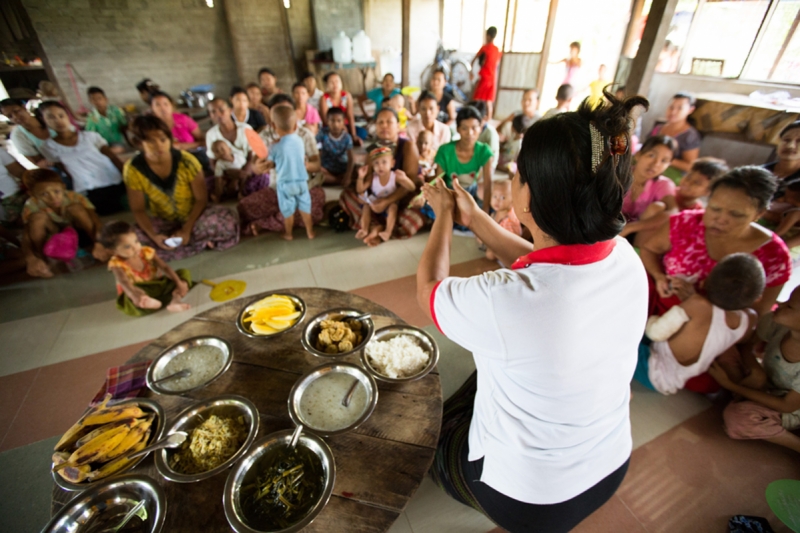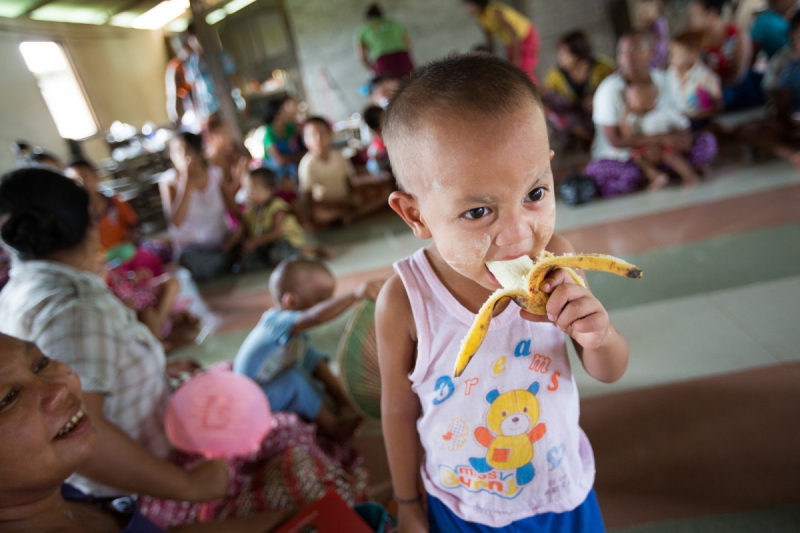




The first 1000 days of a child may seem to be only a brief, inconsequential period of milk and diapers, cribs and wet bedsheets, and a lot of crying and laughing and rolling-around and thumb-sucking.
However, it is also referred to as a person’s “window of opportunity” – a critical part of life that would strongly dictate how a child may fare in the future.
These days of a person’s early youth – from conception until two years of age – comprise the most critical stage of human development, when a child’s body and brain develop at an incredibly fast rate, and good nutrition weighs more than any other time of a person’s life.
According to the article entitled The First 1000 Days published in Myanmar Times on June 2015, strong evidence proves that good nutrition at an early age strengthens children’s probability of achieving their fullest physical and intellectual potential. Children who were properly-nourished during their first 1000 days are less-likely to suffer from disease, more-likely to perform better in school, thus having greater chances of earning more money as an adult compared to those who suffered from undernourishment in their childhood.
This is not the case in Myanmar. Most children of Myanmar are being deprived of a good headstart in life. With the prevalence of child malnutrition, a lot of Myanmar children have already been missing a lot of opportunities even before they actually start pursuing them.
Child Malnutrition in Myanmar
Research confirms that many Myanmar children are being held back from achieving their full potential. According to the Multiple Indicator Cluster Surveys, the latest national nutrition survey conducted by the government and UNICEF in 2009-2010, the rate of stunting among children under five years old is 35 percent. This means that one in three children from Myanmar suffers from chronic undernutrition.
While poverty contributes largely to the high rates of malnutrition in Myanmar, even children in the richest households are likewise vulnerable to undernutrition. Statistics show that approximately one in five children of the wealthiest households in Myanmar suffers from stunted growth.
The plethora of crop production interventions aiming to improve yields in Myanmar does not necessarily lead to good health for everyone. “Decision-makers and food security and livelihoods stakeholders more often than not, misunderstand malnutrition. For many, there is an underlying assumption that simply increasing (crop) production will have a positive impact on nutrition. However, more food does not automatically mean better nutrition,” said Ms. Elizabeth Whelan, a nutrition specialist.
“Historically, humanitarian and development programming in Myanmar was focused on agriculture production and food security, leaving the issues of undernutrition largely ignored. There has been a lack of investment in sustainable systematic and long-term approaches to identify, treat and prevent undernutrition in the country,” she added.
This puts forward the need to focus not just on food production, but on identifying real solutions to address malnutrition.
LIFT’s LEARN
Heeding the call to lessen, if not completely mitigate, child malnutrition in Myanmar, the Livelihoods and Food Security Trust (LIFT) Fund is promoting better health through its country-wide food security and livelihood programs. LEARN, or Leveraging Essential Nutrition Actions to Reduce Malnutrition, in particular, has been in the forefront of their efforts.
Implemented by Save the Children, Action Contre la Faim and Helen Keller International, LEARN raises awareness on the importance of nutrition and the long-term consequences of malnutrition by helping various organizations ensure that their livelihood projects are nutrition-sensitive.
Specifically, the project aims to:
· increase capacity of LIFT Implementing Partners to deliver nutrition-sensitive activities in their target communities;
· integrate nutrition into current and forthcoming LIFT-funded food security and livelihood programmes; and
· support IPs in collecting nutrition-related data and to contribute in building the evidence base in LIFT project areas.
Nutrition as one of LIFT’s Pillars

With technical support from LEARN, LIFT has formally integrated nutrition into its four strategies, with “improved nutrition of women, men and children” recently becoming one of the Fund’s overarching outcomes. This formal inclusion of nutrition in the four strategies aims to provide more opportunities for nutrition-sensitive programming among the Fund and its implementing partners.
And while the addition is recent, it has already started bearing fruit. In Shan and Kachin States, for instance, Metta Development Foundation, in partnership with LIFT, carried out a qualitative research to better understand food consumption practices among women and young children in the area.
After carrying out this research, Metta integrated home gardening activities and nutrition education sessions into their Farmer Field School program to promote local consumption of vegetables. Not only has it provided nutritious food in the area, it likewise raised awareness about the importance of healthy diet among the whole community.
Creating More ‘Windows of Opportunity’ for LEARN
While LEARN has been steadily showing great potential in reducing malnutrition in Myanmar, a lot more obstacles are yet to be conquered along the way. “One ongoing challenge is to help organizations understand that food security and livelihoods projects do not automatically lead to improved nutrition outcomes,” explained Ms. Whelan, who is also the current Program Manager of the LEARN project.
But LEARN’s efforts continue to remain unfazed. According to Ms. Whelan, there are a host of other initiatives in store for the program, such as 1) organizing partners to provide input into the country’s ten-year National Action Plan for Food and Nutrition Security; 2) expanding advocacy efforts with partners on relevant nutrition initiatives, such as the Code of Marketing Breast Milk Substitutes Law in Myanmar; 3) continuing media engagement on key nutrition issues through radio programming focusing on nutrition stories; and 4) researching about food taboos and how they affect nutrition status during the first 1000 days of life.
By integrating nutrition into food security and livelihood development projects, LIFT’s LEARN aims not only to improve the nutrition status of Myanmar people, but to likewise break the vicious cycle of poverty and food insecurity in the country.
With the continuation of the LEARN project, there would definitely be more windows of opportunity waiting to open.